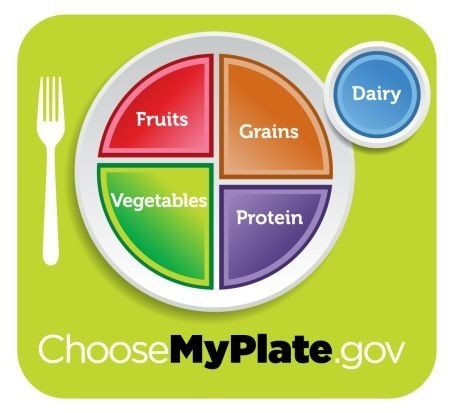
As most of us know by now, in June 2011, the USDA replaced the old MyPyramid with a new symbol, MyPlate. And we can’t really blame them, after all, we eat off of plates, not pyramids. Before the switch, the latest version of the food pyramid, although striped, colorful, and well-intentioned, shed little light on what and how much we are supposed to eat. The new plate symbol is much clearer, showing us what proportion of our plate should be filled with what kinds of food (Sidenote: protein is actually a nutrient, not a food). The symbol is accompanied by the following key messages, aimed at helping us to eat healthfully while controlling portions:
Balancing Calories – Enjoy your food, but eat less. Avoid oversized portions.
Foods to Increase – Make half your plate fruits and vegetables. Make at least half your grains whole grains. Switch to fat-free or low-fat (1%) milk.
Foods to Reduce – Compare sodium in foods like soup, bread, and frozen meals – and choose the foods with lower numbers. Drink water instead of sugary drinks.
What do these guidelines actually mean? Well, the first is pointing out that food should be enjoyed (amen!) but we should not overindulge – in other words, don’t overload your plate! The second focuses on what our plates should actually look like, with perhaps less of an emphasis on whole grains than some nutritionists have suggested. The final guideline pinpoints sodium and sugary drinks as substances to avoid. A helpful caveat to the mention of sodium might be the suggestion to minimize salty snacks as well.
Even if we just start focusing on what our own and our loved one’s plates look like, filling half of them with fruits and vegetables, we will be well on our way to an overall healthy eating plan, assuming we aren’t overloading on salty snack foods, rich desserts, or too much alcohol. There isn’t really much advice for what to eat between meals, unless you choose to go online to personalize your plate where you’ll find a mention of how many “empty” calories you personally can afford each day based on age, sex, weight, and level of activity. These “extra” calories can be used for things like mayonnaise on your turkey sandwich, a small glass of wine with dinner, or a few pieces of dark chocolate for dessert. To our dismay, exercise advice does not accompany the new symbol, even though it was incorporated into the old pyramid and is still advocated by the USDA.
Although many of us don’t have the time, means, or desire to go online, customize our plate, and figure out exactly how much of each food group we need per day, (even though we recommend it; it’s fun!) there’s enough visual guidance in the new symbol to help our families eat better. In this regard, MyPlate is a vast improvement over its predecessor, MyPyramid.
To customize your plate, or find out more about the foods and guidelines it promotes, be sure to take a look at the USDA’s MyPlate website at www.choosemyplate.gov. To read more about the 2010 Dietary Guidelines for Americans off which MyPlate is based, head over to the ADA website atwww.eatright.org. If Family Food can help you and your family build a better plate, feel free to call, e-mail, or leave us a message on Facebook or Twitter:
Facebook: http://www.facebook.com/pages/Family-Food/178786105530247
Twitter: http://twitter.com/#!/Familyfoodllc
Source: http://lowfatcooking.about.com/od/healthandfitness/a/myplate.htm

